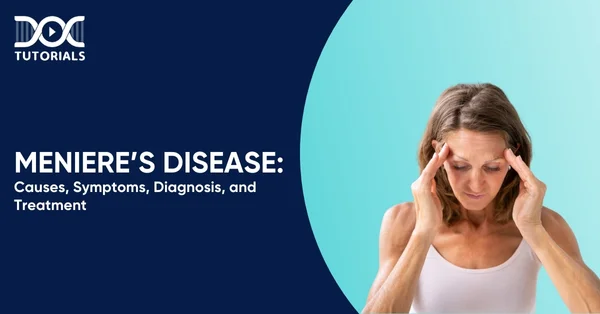Meniere’s Disease | Causes, Symptoms, Diagnosis, and Treatment

Meniere’s disease is an inner ear condition marked by recurring episodes of vertigo, hearing loss, and tinnitus. These attacks may last minutes or several hours. Although not very widespread, the condition can often affect the quality of life and, in case left untreated, it can lead to the permanent loss of hearing and persistent balance disorders.
Therefore, knowing the underlying causes, clinical features, diagnostic methods, and treatment strategies for Meniere’s disease is vital if you are a NEET PG aspirant. This knowledge supports accurate diagnosis and effective patient care, particularly in ENT (ear, nose, throat) and neurology-related cases.
Read on to explore this important topic in detail.
What is Meniere’s Disease?
Meniere’s disease is a long-term vestibular condition caused by changes in the pressure of the fluid within the inner ear. It is characterised by repeated episodes of vertigo along with varying degrees of hearing loss, usually affecting one ear. The condition progresses gradually and requires timely intervention to minimise the risk of lasting damage.
The build-up of inner ear fluid can cause the ear’s structures to expand, similar to a balloon, which leads to symptoms such as tinnitus (a ringing or buzzing in the ear), spinning sensations, and hearing impairment. Although it can develop at any age, the disease tends to be more common among individuals aged between 30 and 60.
What are the Causes of Meniere’s Disease?
The main cause of Meniere’s disease remains unclear, though it is believed to arise from a combination of factors as mentioned below:
- Genetic Factors
In certain situations, Meniere’s condition is hereditary, meaning that it can possibly have a genetic inheritance.
- Viral Infections
The inner ear is exposed to conditions like viral labyrinthitis, which may contribute to the development of the condition.
- Disruption in Inner Ear Fluid Levels
The endolymph is the fluid within the inner ear, which, if produced or drained abnormally, may cause abnormal pressure changes.
- Autoimmune Activity
Studies reveal that due to a breakdown in immune system functioning, the body has the ability to attack the tissue in the inner ears.
- Physical Injury
Trauma to the head or ear region may impair the structures that are responsible for hearing and balance, thus contributing to the onset of the condition
- Allergic Reactions
In some individuals, allergies might disturb inner ear fluid balance and act as a triggering factor.
What are the Symptoms of Meniere’s Disease?
Meniere’s disease is a progressive disorder, which indicates that the symptoms may worsen over time if left untreated. After an episode, the symptoms may completely subside for a considerable period before returning. The condition is marked by a range of signs and symptoms:
- Recurring Episodes of Vertigo
Sudden and unpredictable dizzy spells are a hallmark of the condition. These attacks typically last from 20 minutes to several hours, often accompanied by nausea during more intense episodes.
- Tinnitus
This involves a persistent ringing, buzzing, or hissing sound in the ear. While not a disease itself, tinnitus serves as a symptom of Meniere’s disease.
- Hearing Loss
In the initial stages, there is variable loss of hearing, but most of the severe cases ultimately progress to permanent hearing loss.
- Aural Fullness
A feeling of pressure or fullness in the affected ear is common and often occurs before a vertigo episode, easing once the attack passes.
What are the Risk Factors of Meniere’s Disease?
Several factors may increase the likelihood of developing Meniere’s disease:
- Age: The condition most commonly arises in middle adulthood.
- Genetic Tendency: A family history of the disorder may raise the chances of developing it, pointing to a possible inherited link.
- Sex: It is believed that it could take place more frequently in females than males.
- Autoimmune disorders: People with autoimmune conditions like lupus, rheumatoid arthritis, ankylosing spondylitis, etc., might be more susceptible to the occurrence of Meniere’s disease.
How to Diagnose Meniere’s Disease?
This disease is considered a rare condition, though its key symptoms are relatively common. A confirmed diagnosis typically requires the presence of:
- At least two episodes of vertigo
- Documented hearing loss through an audiological examination
- Tinnitus or a sensation of pressure or fullness in the affected ear
A clinical assessment will usually include a detailed medical history and physical examination of the ears to exclude other possible causes of the symptoms. To support diagnosis, various tests are conducted, which are given below:
- Audiometry (Hearing Tests)
These evaluate hearing sensitivity across different pitches and volumes, as well as the ability to distinguish between similar-sounding words. Individuals with Meniere’s disease often show hearing loss at both low and high frequencies, with mid-range hearing relatively unaffected.
- Balance Function Tests (Vestibular Testing)
The following are the balance function tests that medical professionals conduct:
- Videonystagmography (VNG) or Electronystagmography (ENG): These measure involuntary eye movements while following visual targets or during exposure to warm and cool air directed into the ear canal.
- Rotary Chair Testing: The patient sits in a rotating, computer-controlled chair, and eye movements are monitored to assess inner ear response.
- Vestibular Evoked Myogenic Potential (VEMP): Evaluates the inner ear’s muscular response to sound stimuli.
- Computerised Dynamic Posturography (CDP): This assesses postural stability under different conditions using a moving platform, with the individual secured in a safety harness.
- Video Head Impulse Test (vHIT): Analyses the eyes’ ability to maintain focus during sudden head movements using video tracking.
- Electrocochleography: It monitors the inner ear fluid pressure, which can provide information to show abnormal fluid levels associated with Meniere’s disease.
What are the Treatment Options for Meniere’s Disease?
Management of Meniere’s disease primarily aims to control symptoms rather than cure the condition. Common approaches include:
- Medication: Diuretics are often prescribed to reduce fluid retention, along with medicines to manage vertigo and nausea.
- Vestibular Rehabilitation: Exercise-based therapy is used to improve balance and decrease dizziness.
- Hearing Aids: Amplification devices can help individuals to experience notable hearing loss.
- Intratympanic Injections: These are administered into the middle ear to help alleviate symptoms.
Some individuals benefit from non-invasive therapies, such as:
- Vestibular Rehabilitation Therapy (VRT): Recommended when balance recovery between vertigo episodes becomes challenging, this structured exercise programme aids in restoring stability.
- Hearing Devices: Use of a hearing aid in the affected ear may support hearing improvement.
- Positive Pressure Therapy: For persistent vertigo, a Meniett pulse generator can be used at home. This device sends pressure pulses through a ventilation tube to relieve inner ear pressure.
Some of the common surgical treatment options for Meniere’s disease are as follows:
- Endolymphatic Sac Decompression (ESD): In this process, a small part of the bone is chiselled around the inner ear in order to increase fluid release and remove any pressure.
- Vestibular Nerve Section (VNS): This is one type of surgery that aims at decreasing vertigo by cutting the nerve that is supposed to convey the signals concerning balance to the brain. Nevertheless, it presents a possible hearing damage.
- Labyrinthectomy: In extreme cases where vertigo is disabling, the inner ear may be surgically removed. It leads to a complete loss of hearing in the individual’s treated ear.
- Cochlear Implant: For individuals with substantial hearing loss, a cochlear implant might be used to restore partial hearing ability.
FAQs About Meniere’s Disease
- Is Meniere’s disease considered serious?
Meniere’s disease is not life-threatening; rather, it can appear unexpectedly and without any preceding warning, thus disorienting daily activities and largely disrupting the general quality of life.
- What can trigger Meniere’s disease?
The common stimuli that may cause Meniere’s disease can be emotional stress, physical fatigue, psychological stress, the presence of other diseases, some dietary factors, altered blood pressure, and increased saltiness.
- Does Meniere’s disease resolve on its own?
Meniere’s disease is a chronic and progressive condition, meaning its symptoms may become more severe over time. The rate of progression can vary. Some individuals experience a slow decline, others notice more rapid changes, while a few may enter a period of remission without a known cause.
Conclusion
Having an in-depth knowledge of Meniere’s disease, along with its causes, symptoms, diagnostic methods, and treatment options, is crucial for effective clinical application and academic preparation. Complications can be avoided by early diagnosis and timely symptom control, which enhances patient outcomes.
This topic can help the NEET PG aspirants improve clinical decision-making in the event of a vestibular disorder. DocTutorials offers everything you need to learn, including high-yield video lectures, expert-led sessions, and evidence-based study materials to enable you to succeed in complex topics and be in your target rank.
Explore our NEET PG course today and take a confident step towards your medical goals!
Latest Blogs
-

NEET SS Exam 2024: Analysis, Key Dates, Counselling
The NEET SS 2024 exam kicked off on March 29, 2025. Over two days and two slots, candidates across 13…
-

NEET PG Registration 2025: An Essential Guide For Exam Prep
The NEET PG registration, which is conducted online, is a crucial step in the exam process. Filling out the NEET…
-

NEET PG Syllabus 2025: A Must-Have Complete Guide for Exam Success
The NEET PG Syllabus acts as one of the foundation stones for aspiring postgraduate medical students like you who are…




